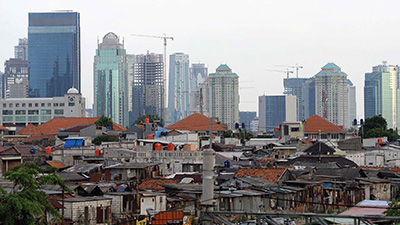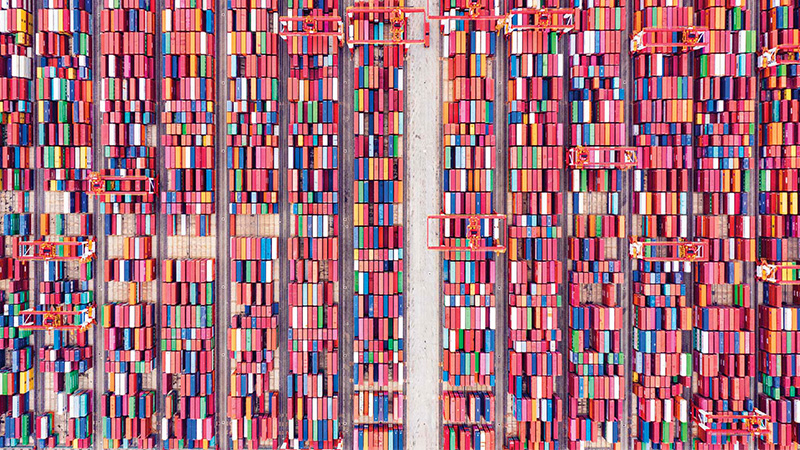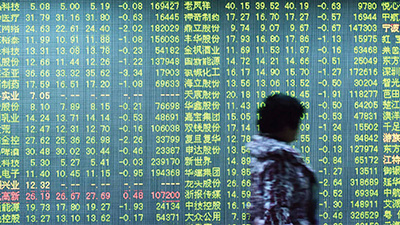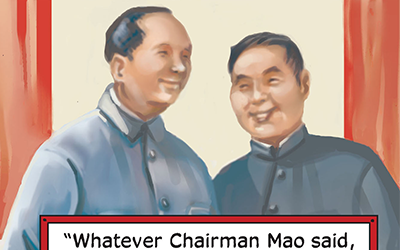Economics in the Global Age
Teacher Resources
Driving Question: How have our economic networks and systems of production and distribution been affected by the era of intense globalization?
Globalization has knitted our world together into a single global economy. Many of the things we use or eat are made and grown in totally different parts of the world, by people we will never meet. Does this global supply chain and interconnected economy create a world of economic opportunity or inequality? In this lesson, you’ll explore this question as you follow goods across the world.
Learning Objectives
- Explain the continuities and changes in the global economy from 1900 to the present.
- Use graphic biographies to support, extend, or challenge the overarching narratives from this period.
Vocab Terms:
- consumption
- deforestation
- economic liberalization
- liberalize
- monoculture
- privatize
- regulation
Opener: Economics in the Global Age
To teach this lesson step, refer to page 3 of the Lesson 9.4 Teaching Guide.
In addition to thinking about the upsides and downsides of globalization, you might also want to consider the Future of globalization.
There are a lot of positives that can come from globalization. But what are the downsides? Find out in this opener activity.
Is the World Flat or Spiky?
To teach this lesson step, refer to page 3 of the Lesson 9.4 Teaching Guide.
You’ve seen how globalization’s impact has been uneven. Now explore the concept of a “flat” vs. “spiky” world—which do you think we live in?
-
Guiding Questions
-
Before you read
Preview the questions below, and then skim the article. Be sure to look at the section headings and any images.
While you read
Look for answers to these questions:
- What does Thomas Friedman argue in his book?
- What are the “dynamic forces” that have driven Friedman’s described stages of globalization?
- How did Richard Florida critique Friedman’s book?
- How does Richard Florida use urbanization as evidence to support his argument?
- What is Dr. Vandana Shiva’s critique of Friedman?
After you read
Respond to the following questions:
- The idea of a “flat” or “spiky” world can be hard to understand. So, let’s make it more local. What are some ways that the distribution of power (or authority) in your school is flat or spiky?
- Richard Florida and Dr. Shiva both argue that globalization has made inequality worse than ever before. Do you agree or disagree? Why? Can you think of any historical examples of when inequality was worse?
Source Collection: Economics in the Global Age
To teach this lesson step, refer to page 4 of the Lesson 9.4 Teaching Guide.
Looking for more resources to support your students in sourcing? The Sourcing Topic Page has all OER Project sourcing materials in one location.
Explore sources that examine economic changes during the late twentieth century around the world: from China to Chile, from Western Europe and the United States, to Southeast Asia. We recommend using the Quick-Sourcing Tool to help you analyze these sources.
Making Claims: Globalization
To teach this lesson step, refer to page 5 of the Lesson 9.4 Teaching Guide.
Your students should have a lot of practice making and testing claims, but there is always room to grow. Give them feedback using the Claim Testing: Feedback Form.
Practice your claim- and counterclaim-making skills while also exploring the complex topic of the environmental impact of globalization.
Rise of China
To teach this lesson step, refer to page 6 of the Lesson 9.4 Teaching Guide.
China took an economic “great leap forward” during the twentieth century—but has new wealth created new problems?
-
Guiding Questions
-
Before you read
Preview the questions below, and then skim the article. Be sure to look at the section headings and any images.
While you read
Look for answers to these questions:
- What were some of the important developments in the economy of the People’s Republic of China in the years shortly after its 1949 founding?
- What led to the Great Leap Forward and the Cultural Revolution and what were some of the results?
- What were some of the important aspects of the post-Mao policies under Deng Xiaoping?
- Alongside the increasing national wealth of the People’s Republic of China, what are some of the downsides of this economic growth?
After you read
Respond to the following question: Deng Xiaoping referred to post-Mao reforms as “socialism with Chinese characteristics.” Based on the evidence in this reading, is this just capitalism under one-party rule? Why or why not?
Global China into the Twenty-first Century
To teach this lesson step, refer to page 7 of the Lesson 9.4 Teaching Guide.
There is no doubt that China is a modern superpower and a hub of globalization, under the authoritarian rule of the Chinese Communist Party. But what does that actually mean for the Chinese people?
-
Guiding Questions
-
Before you watch
Preview the questions below, and then review the transcript.
While you watch
Look for answers to these questions:
- According to Francesca Hodges, about what proportion of the world’s population is Chinese?
- What does the data suggest has happened to China’s economy over the past century? What has been the impact on the Chinese people?
- According to Dr. Crystal Chang, why do the Chinese people generally support or allow the Communist Party to continue to govern, despite being authoritarian?
- According to Professor Chang, how has China benefited from globalization, and how has that changed over time?
- Does the Chinese government allow and encourage dissent? How does it discourage negative opinion?
After you watch
Respond to the following questions:
- To what extent does this video explore the continuities and changes in the global economy from 1900 to present?
- Consider Dr. Chang’s evaluation of both freedoms and economic change in China. Do you think it is worth giving up some freedoms, and allowing some oppression, if most people are benefiting economically? Compare these choices to the ones made in your own country.
Key Ideas
Graphic Biography: Hua Guofeng
To teach this lesson step, refer to page 8 of the Lesson 9.4 Teaching Guide.
Was the former Chinese Premier Hua Guofeng responsible for massive economic change in China? Or was he perhaps just lucky to govern in a period when global and national trends were shifting? Explore those questions in the graphic biography below.
-
Guiding Questions
-
Before you read
Preview the questions below, and then skim the comic, paying attention to things like prominent colors, shapes, and types of text and fonts. How do you know where to start and in which direction to read? What’s in the gutters (the space between panels)? Who or what is the focus of the comic?
While you read
Look for answers to these questions:
- What was the great transformation in China’s economy that took place after 1976?
- What did Hua Guofeng do as Premier to help lead to this transformation?
- Who usually gets credit for the reforms that led to China’s economic growth in this period, according to the author? Why does Hua Guofeng not?
- How does the artist use artistic design to demonstrate the transformation in China’s economy between 1976 and 2016?
After you read
Respond to the following questions:
- To what extent does this biography explain the continuities and changes in the global economy from 1900 to the present?
- How does this biography of Hua Guofeng support, extend, or challenge what you have learned about China’s economic transformation in the 1980s?
Closer: Economics in the Global Age
To teach this lesson step, refer to page 9 of the Lesson 9.4 Teaching Guide.
How do you use Gapminder? Read through this Community thread for extra ideas before using this activity with your students.
Dollar Street imagines a world where everyone lives on the same street and the houses are ordered by income: the poorest people live at one end, and the richest live at the other end. Explore this world and consider the differing impacts of globalization.
Bangalore: City of High Tech
To teach this lesson step, refer to page 10 of the Lesson 9.4 Teaching Guide.
Bangalore in India is a city that encompasses both the positive and negative aspects of globalization.
-
Guiding Questions
-
Before you read
Preview the questions below, and then skim the article. Be sure to look at the section headings and any images.
While you read
Look for answers to these questions:
- What problems did British colonialism cause for the Indian economy? Did decolonization fix these problems?
- What big technological innovations changed India’s economy in the 1990s? What were their impacts?
- How has globalization transformed Bangalore?
- What evidence does the author offer for the positive impacts of globalization in Bangalore?
- What evidence does the author offer for the negative impacts of globalization in Bangalore?
After you read
Respond to the following questions:
- This article is pretty optimistic about the potential of globalization for Bangalore. Using evidence from this article and others you have encountered in this unit, do you agree? Is intense globalization likely to lead Bangalore to a bright high-tech future?
- Describe the continuities and changes that Bangalore experienced concerning the global economy from 1900 to the present.









